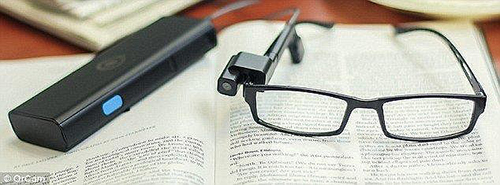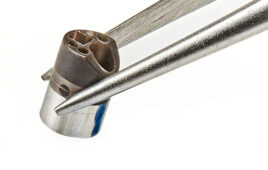
(Credit: Daily Mail)
Approximately 246 million people worldwide have low vision. This sight loss impairs a person’s ability to do simple daily tasks. Optical and electronic devices such as hand-held magnifiers, tele-microscopic glasses and computer and video magnifiers can help. But, typically these devices are bulky, cumbersome or not readily portable. With recent advancements in wearable electronic devices and optical character recognition technology that converts images to computer-readable text, University of California, Davis researchers hypothesized that these newer technologies could help improve patients’ ability to function in daily life. To test their theory, researchers asked a group of visually impaired patients to use a wearable artificial vision device to see its impact. They found that the device vastly improved patients’ daily productivity.
The researchers used the Orcam My Eye for their study. The device is unique because it clips to glasses, making it hands-free. It features a miniature camera that sees and recognizes what the user is viewing, whether text or a face, and then reads what it is seeing to the user via a small bone-conduction earpiece. The user activates the device by simply pointing a finger to the object or text, tapping it or pressing a trigger button.
Researchers tested the device on 12 legally blind people, who all had a visual acuity of less than 20/200. Study participants performed a 10-item test simulating activities of daily life, including recognizing products and reading a variety of items such as emails, letters, newspapers, book and signs. They earned one point for the successful completion of each item, and a zero for each not completed. The total possible score was 10. The researchers studied the participants at three stages. First, they observed the participants doing the tasks without the device, then while wearing it after receiving a 90- to 120-minute training session and finally after wearing the device for one week.
The researchers’ findings were as follows: •Without wearing the device, the participants’ average score was 2.5 out of 10. •When they first tried the device, their average score improved to 9.5 out of 10. •After a week of wearing the device, the average score of participants improved to 9.8 out of 10. •Seven of the patients completed the test using other low-vision aids such as magnifying glasses, resulting in an average score of 6. When they switched to the portable device, their average score improved to 9.7.
“While there have been many advances in eye care, the options for assistance in completing daily tasks are limited and cumbersome,” said Elad Moisseiev, M.D., a vitreoretinal surgeon who was the study lead at U.C. Davis, but is now with the Tel Aviv Medical Center, Israel. “This represents a new step in the evolution of assistance devices for people with low vision, giving them hope for improving their functionality, independence and quality of life.”
The pilot study was the first to evaluate the device in people with low vision, establishing its efficacy and ease of use and demonstrating the achievement of statistically significant differences in test scores, said Dr. Moisseiev. He noted that additional studies should include more people, ideally stratifying them by level of visual impairment.
A Portable Artificial Vision Device is a Useful Aid for Patients with Low Vision is being presented at AAO 2016, the 120th annual meeting of the American Academy of Ophthalmology. The event is being held in conjunction with the Asia-Pacific Academy of Ophthalmology Oct. 14-18 at McCormick Place, Chicago. Known as the place “Where all of Ophthalmology Meets®,” the Academy’s annual meeting is the world’s largest conference for eye physicians and surgeons. For more information, see AAO 2016 highlights.




